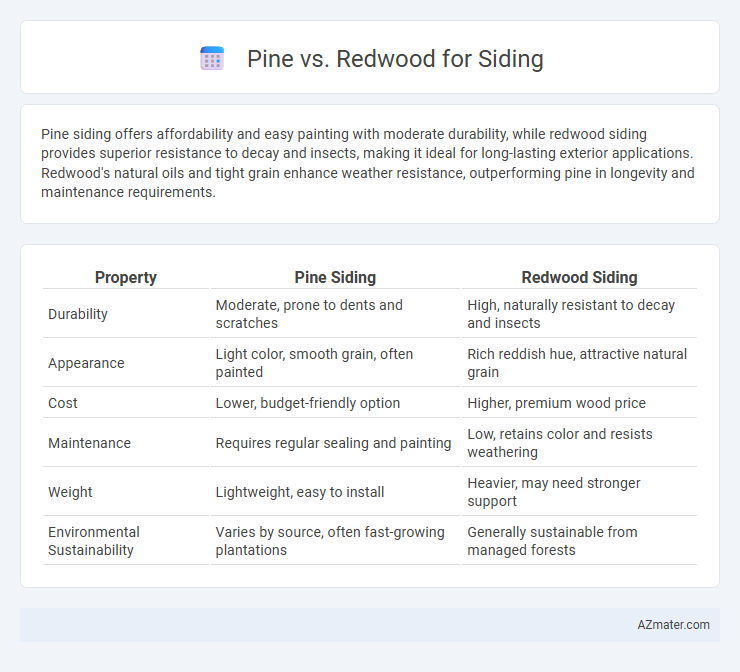Pine siding offers affordability and easy painting with moderate durability, while redwood siding provides superior resistance to decay and insects, making it ideal for long-lasting exterior applications. Redwood's natural oils and tight grain enhance weather resistance, outperforming pine in longevity and maintenance requirements.
Table of Comparison
| Property | Pine Siding | Redwood Siding |
|---|---|---|
| Durability | Moderate, prone to dents and scratches | High, naturally resistant to decay and insects |
| Appearance | Light color, smooth grain, often painted | Rich reddish hue, attractive natural grain |
| Cost | Lower, budget-friendly option | Higher, premium wood price |
| Maintenance | Requires regular sealing and painting | Low, retains color and resists weathering |
| Weight | Lightweight, easy to install | Heavier, may need stronger support |
| Environmental Sustainability | Varies by source, often fast-growing plantations | Generally sustainable from managed forests |
Pine vs Redwood: An Overview for Siding
Pine and redwood are popular siding materials, each offering unique benefits in durability and appearance. Redwood is naturally resistant to decay and insects, providing superior longevity and minimal maintenance compared to pine, which requires treatment to enhance durability. Pine's affordability and ease of staining make it a versatile choice but may demand more upkeep in harsh climates than redwood siding.
Durability Comparison: Pine vs Redwood Siding
Redwood siding offers superior durability compared to pine due to its natural resistance to decay, insects, and moisture, making it ideal for exterior applications in diverse climates. Pine siding, while more affordable and easier to work with, requires regular maintenance, such as sealing and painting, to prevent warping, rot, and insect damage over time. Redwood's dense grain structure and natural oils provide long-lasting protection, reducing the frequency and cost of upkeep compared to pine siding.
Natural Resistance to Decay and Insects
Redwood exhibits a higher natural resistance to decay and insects compared to pine, making it a preferred choice for exterior siding in humid or pest-prone environments. The inherent tannins and oils in redwood create a durable barrier against fungal growth and termite damage. Pine siding requires additional treatment with preservatives to achieve comparable protection and longevity in outdoor applications.
Climate Suitability for Pine and Redwood Siding
Pine siding performs well in moderate climates with low humidity, as it is more prone to moisture damage and requires regular sealing to prevent warping and decay. Redwood siding offers superior resistance to rot and insect damage, making it ideal for humid or coastal environments with frequent moisture exposure. Both wood types benefit from proper maintenance, but redwood's natural oils provide enhanced durability in variable and wet climates.
Appearance and Grain Differences
Pine siding typically features a lighter color palette with a more uniform, fine grain pattern, offering a smooth and consistent appearance ideal for traditional or rustic styles. Redwood siding stands out with its rich reddish hue and pronounced, varied grain patterns that add depth and natural character to exterior surfaces. The distinct grain texture of redwood creates a visually dynamic facade, while pine's subtler grain allows for easier staining and a versatile finish.
Maintenance Requirements: Pine vs Redwood
Pine siding requires regular sealing and painting every 3-5 years to protect against moisture, pests, and UV damage due to its softer wood composition. Redwood siding naturally resists decay, insects, and warping, needing minimal upkeep beyond occasional cleaning and resealing every 7-10 years. The dense grain and natural oils in redwood make it a lower-maintenance option compared to pine's higher maintenance demands for longevity.
Cost Analysis: Initial and Long-Term Investments
Pine siding typically offers a lower initial cost, making it a budget-friendly option for homeowners seeking immediate savings. Redwood siding, while more expensive upfront, provides superior durability and resistance to decay, which can reduce maintenance and replacement expenses over time. Factoring in the long-term investment, redwood's extended lifespan and minimal upkeep may result in overall cost savings compared to the frequent repairs often required with pine siding.
Environmental Impact and Sustainability
Pine siding typically comes from faster-growing, sustainably managed forests, making it a more renewable resource with lower carbon footprints due to quicker regrowth cycles. Redwood, while naturally resistant to decay and insects, often involves slower growth rates, which can lead to higher environmental impact from harvesting older, mature trees. Pine's availability in certified sources like FSC and PEFC enhances its sustainability credentials compared to redwood, which may be less commonly certified and more prone to deforestation concerns.
Installation Considerations and Ease
Pine siding offers easier installation due to its softer texture and lighter weight, allowing for quicker cutting and fastening compared to Redwood, which is denser and more challenging to work with. Redwood requires pre-drilling and specialized tools to avoid splitting and ensure secure attachment, increasing installation time and complexity. Pine is often preferred for DIY projects, while Redwood siding installation typically demands professional expertise to handle its durability and maintain its natural aesthetic.
Pine or Redwood: Which Is Best for Your Home Siding?
Pine offers affordability and ease of installation for home siding, with its softwood properties allowing for quick customization and painting, but it requires regular maintenance to prevent moisture damage and insect infestation. Redwood, known for its natural resistance to rot, decay, and insects due to its high tannin content, provides superior durability and longevity, making it ideal for outdoor siding applications in various climates. Choosing between pine and redwood depends on budget constraints and desired maintenance levels, with redwood excelling in durability and pine favored for cost-efficiency and ease of use.

Infographic: Pine vs Redwood for Siding
 azmater.com
azmater.com